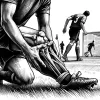A few weeks ago, I started sharing a series of Twitter posts that I referred to as "Orthopedic Truth." They're sort of a distillation of spending an entire career thinking, questioning, listening, and iterating.
One clear thing: We are not nearly as far along as I thought we would be. We keep publishing the same research and trying the same procedures, expecting a different result.
These have been wildly popular, and we hope you enjoy them. Following the Twitter post will be a short recap of the message(s) I was trying to convey.
Here's the post from Twitter in all of its thinking-out-loud glory:
Orthopedic Truths #4
The ACL:
The ACL is important for some people to remain active.
Others tolerate its loss very well.
ACL tears are too common in sports.
ACL tear prevention programs exist... they work, yet community/ school sports don't utilize them.
ACL tears are more common in athletes participating in the same sport year-round.
ACL surgery, despite years of research and practice, remains an imperfect solution to a complex problem.
Do all ACL tears require surgery?
No
But yours might.
Your child should probably have it.
It's the secondary injuries we worry about.
What about adults?
Many do fine without ACL surgery.
Some don't.
But it often pays to wait and see.
Everyone's knee feels unstable initially.
Very often, that stability improves with time and physical therapy.
Therefore, for adults, you might want to wait before booking that surgery date.
Why is the surgery an imperfect solution?
Because the native ACL isn't a straight, single-diameter structure, but our reconstruction is.
Secondary injuries can include meniscus tears and cartilage injuries.
Those will increase the risk of developing arthritis.
The history of reconstruction is wild... and somewhat circular.
Back in the 80's and 90's we argued about which graft worked well.
We still have those arguments.
Now, we added the quad tendon graft to the argument.
Would I take hamstrings from a sprinting athlete... no, not really.
Am I a quad enthusiast? Not yet.
When the MOON group announces their data, then I might.
But it took 20 years for that to come out for hamstrings vs BTB.
BTB remains the gold standard... and will for a while.
But we tried Goretex.
We tried other things, too.
Those didn't end well.
Oh. We have this scope thing. Let’s keep reconstruction via one tunnel. Evolution be damned.
The ACL has had the same femoral footprint (attachment) for millions of years. But heck.
Let’s put that tunnel here.
It worked for some... but many failed.
We tried to repair them, but they failed.
We developed tools to place the ACL where nature intended it.
But going too distal seemed to increase the risk of re-rupture, too.
Now we cheat a little back up the wall on the lateral condyle.
We tried reconstructing both bundles—certainly, that would work better. I tried them, too, but that didn't work.
Fixation... we need screws. The metal screw worked very well. It was predictable and easy to remove.
Oh.. I hate seeing screws on the x-ray. Let’s use these awesome bioscrews.
Wow…, I haven’t seen a cyst that big before
Sadly... those screws dissolved the bone around the graft, too.
Then, we devised some wild, stupid ways to secure the graft that make revision surgery challenging.
Thankfully, most of those are gone now.
Along the way, we thought we would save our patient's tissue by using cadaveric tissue or allograft.
There were disease-spreading issues early on.
But that got better.
Oops... they fail very often in kids.
We don't use them in kids anymore.
We can use them in adults.
(But your own tissue is better.)
Hey... It's been 30 years, so let's repair them again.
That still didn't work.
Hey... let's put this little sponge in the repair.
Okay... That might work... the jury is still out on this.
"ACL tears never heal without surgery."
But it appears that they do!
Enter the cross-brace protocol.
It's annoying for the patient.
It doesn't pay the surgeon as well.
But it appears to work. For some.
The jury is still out. More research is needed.
But... ACL tears can heal.
Rehab. “I let my patients return to sports in 6 mos”.
Just don't!
Don’t mess with the biology of healing.
Kids should wait 12-24 mos to return to sports.
I don't think that most parents understand the recurrent tear rate.
Most kids I see out there are not properly/fully rehabilitated after surgery.
It's hard when our lovely insurance companies approve 8 PT visits for an ACL patient.
Multinational/well-researched protocols exist for the rehab of an ACL athlete.
But they're not used often.
Ah... this messy little ligament has generated reams of "research" over the years. Much of it is nonsense, but some solid data exists.
The controversies around how to manage these athletes persist.
I would have thought we would have been further along, but here we are.
Stay tuned... I imagine we are still having the same conversations in 20 years.
Ask your school to implement ACL tear prevention programs.I think you can get a sense of the frustration that I feel as my career draws to a close. Let's dive in and look closer at the current state of the ACL.
Understanding ACL Tears: Beyond the Basics
Orthopedic Truth: The ACL
The anterior cruciate ligament (ACL) is a critical structure for knee stability, particularly in athletes. Yet, the management of ACL tears remains a complex and often debated topic.
The Role of the ACL
For many, the ACL is essential for maintaining an active lifestyle. However, not everyone requires surgery after an ACL tear. While some individuals tolerate ACL deficiencies well, others, particularly athletes, face significant challenges. ACL tears are notably prevalent in sports, especially those involving cutting and pivoting movements.
Prevention Programs: Underutilized and Effective
Despite the high incidence of ACL tears, effective prevention programs are not widely implemented in community and school sports. These programs, which focus on neuromuscular training, have proven to reduce the risk of ACL injuries. Yet, their adoption remains limited.
Year-Round Sports and Increased Risk
Participating in the same sport year-round increases the risk of ACL tears. The repetitive stress and lack of cross-training contribute to this heightened risk.
The Imperfect Solution of ACL Surgery
ACL surgery, despite extensive research, is not a perfect solution. The native ACL is a complex structure, and our reconstructions cannot fully replicate its natural anatomy. The history of ACL surgery is filled with trial and error, from using different grafts to various fixation methods, many of which have not stood the test of time.
Surgical Decisions: Individualized and Complex
Not all ACL tears require surgery. For children, surgery is often recommended to prevent secondary injuries like meniscus tears and cartilage damage, which increase the risk of arthritis. For adults, a conservative approach with physical therapy might suffice. Stability often improves over time, and the decision to operate can sometimes be deferred.
Why Surgery Isn't Always the Answer
Surgical reconstruction of the ACL is challenging because it cannot perfectly mimic the native ligament's intricate structure. Historical attempts to innovate, such as using Gore-Tex or bioscrews, have often led to complications.
Evolving Techniques and Persistent Challenges
The journey of ACL reconstruction has been marked by ongoing debates and evolving techniques. From hamstring grafts to the more recent interest in quad tendon grafts, orthopedic surgeons continue to seek the optimal solution. Fixation methods have also evolved, with metal screws remaining a reliable option despite the initial excitement around biodegradable alternatives.
The Role of Cadaveric Tissue
Allografts, or cadaveric tissues, offered a promising alternative but presented their own set of challenges. While safer now, they are not suitable for children due to higher failure rates.
Innovative Repairs and Healing Protocols
The idea that ACL tears never heal without surgery is being challenged by new protocols, such as the cross-brace protocol, which encourages natural healing. However, these methods require more research and are not yet widely accepted.
Rehabilitation: The Critical Component
Proper rehabilitation is crucial for recovery. Unfortunately, insurance limitations often restrict the number of physical therapy sessions, leaving many patients under-rehabilitated. Effective rehabilitation protocols exist but are underutilized.
The Ongoing Debate
ACL tears continue to generate extensive research, much of it inconclusive. The controversies surrounding their management persist, and it is likely that these discussions will continue for years to come.
Conclusion
While the perfect solution for ACL tears remains elusive, understanding the complexities and individualizing treatment is essential. Prevention programs should be more widely implemented, and a cautious, well-informed approach to surgery and rehabilitation is crucial for optimal outcomes.
Stay informed and proactive about ACL injury prevention and management. Ask your community and schools to implement effective prevention programs to protect athletes from this common yet challenging injury.





